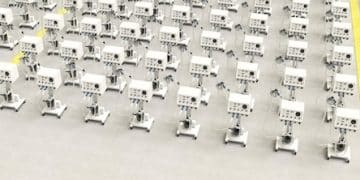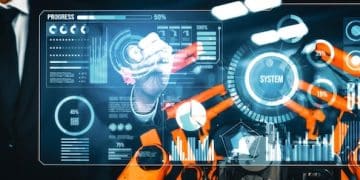Automation’s Impact: Navigating US Job Market Opportunities & Challenges

Automation is reshaping the US job market, presenting both significant opportunities for increased productivity and efficiency in businesses and considerable challenges related to job displacement and the need for workforce retraining.
The rise of automation is undeniably transforming the American workforce. Understanding its impact is crucial for businesses and workers alike. Let’s explore The Impact of Automation on the US Job Market: Opportunities and Challenges for Businesses.
Understanding Automation’s Reach in the US
Automation is no longer a futuristic concept; it’s a present-day reality permeating various sectors of the US economy. From manufacturing to customer service, automated systems are being implemented to boost productivity and reduce operational costs.
Current State of Automation
Currently, automation technologies like robotics, artificial intelligence (AI), and machine learning (ML) are being integrated into different industries at varying paces. The level of automation differs based on the specific processes and the availability of technology.
Industries Most Affected
Some industries are experiencing more profound changes than others. Manufacturing, transportation, and customer service are at the forefront of automation adoption, with significant impacts on job roles and skill requirements.
- Manufacturing: Increased use of robots for assembly and quality control.
- Transportation: Self-driving vehicles and automated logistics systems.
- Customer Service: Chatbots and AI-driven support platforms.
- Finance: Algorithmic trading and automated financial analysis.
Automation’s growth is driven by the need for increased efficiency, reduced costs, and improved quality. Understanding the current state of automation helps businesses prepare for future challenges and opportunities.

The Opportunities Presented by Automation
While the focus is often on job displacement, automation also unlocks a range of opportunities for businesses and the economy at large. These opportunities can lead to growth, innovation, and improved quality of life.
Increased Productivity and Efficiency
One of the primary benefits of automation is the potential for increased productivity. Automated systems can operate continuously, without the need for breaks or rest, leading to higher output levels.
Cost Reduction
Automation can significantly reduce operational costs for businesses. By automating repetitive tasks, companies can minimize labor expenses and reduce the risk of human error, which can be costly.
Innovation and New Business Models
Automation drives innovation by enabling businesses to explore new possibilities and create novel products and services. It paves the way for the development of new business models that were previously unfeasible.
- Improved product quality due to consistent automated processes.
- Faster production cycles, enabling quicker response to market demands.
- Enhanced data analysis, leading to better decision-making.
- Opportunities to focus human resources on higher-value tasks.
Embracing automation allows businesses to leverage new technologies to streamline operations, enhance innovation, and achieve long-term growth.
Challenges and Concerns for the US Workforce
Despite the opportunities, automation presents significant challenges for the US workforce. Job displacement, the need for retraining, and ethical considerations are among the most pressing concerns.
Job Displacement and Unemployment
One of the most significant concerns surrounding automation is the potential for job displacement. As machines and AI become capable of performing more tasks, many jobs currently held by humans may become obsolete.
The Need for Retraining and Upskilling
To mitigate the negative effects of job displacement, there’s an urgent need for retraining and upskilling initiatives. Workers need opportunities to acquire new skills that are relevant in an automated economy.
Ethical Considerations
Automation also raises important ethical questions. Issues such as algorithmic bias, data privacy, and the potential for increased inequality need to be addressed to ensure that automation benefits society as a whole.
To navigate the challenges, businesses and policymakers need to invest in education, training, and social safety nets to support workers during this transition.
Strategies for Businesses to Adapt to Automation
Successful adaptation to automation requires a strategic approach. Businesses must focus on integrating technology effectively, investing in workforce development, and fostering collaboration.

Integrating Technology Effectively
Businesses should carefully assess their automation needs and develop a strategy for integrating technology in a way that complements human capabilities. This involves identifying tasks that can be automated and ensuring that the implementation process is smooth and efficient.
Investing in Workforce Development
Investing in workforce development is crucial. Companies need to provide training and upskilling opportunities for their employees to prepare them for new roles and responsibilities in an automated environment.
Fostering Collaboration Between Humans and Machines
Automation should not be viewed as a replacement for human workers but rather as a tool that enhances their capabilities. Fostering collaboration between humans and machines can lead to more innovative and effective solutions.
- Creating a culture of continuous learning.
- Encouraging employees to embrace new technologies.
- Providing resources for ongoing training and development.
Adapting to automation requires a proactive and strategic approach, focused on leveraging technology to enhance human capabilities and drive business growth.
Government Policies and Support for Automation Transition
Government policies play a crucial role in facilitating a smooth transition to an automated economy. Policies related to education, training, and social safety nets are essential for supporting workers and businesses.
Education and Training Initiatives
Governments can invest in education and training initiatives to equip workers with the skills they need to succeed in an automated job market. This includes funding for vocational training programs, apprenticeships, and higher education opportunities.
Social Safety Nets and Support Programs
Social safety nets, such as unemployment insurance and job placement services, are crucial for supporting workers who lose their jobs due to automation. These programs can provide financial assistance and help workers find new employment opportunities.
Incentives for Businesses to Invest in Training
Governments can offer incentives for businesses to invest in training and upskilling their employees. This can include tax credits, grants, and other financial assistance programs designed to encourage workforce development.
Government policies are crucial for creating an environment that supports both innovation and worker well-being in the face of increasing automation.
The Future of Work in an Automated US Economy
Looking ahead, the future of work in the US will be shaped by the ongoing integration of automation. Understanding the potential trends and challenges can help businesses and workers prepare for what’s to come.
Emerging Trends in Automation Technology
Several emerging trends in automation technology are poised to have a significant impact on the job market. These include advancements in AI, robotics, and machine learning, as well as the increasing use of automation in new industries.
Potential Long-Term Impacts on Employment
The long-term impacts of automation on employment are complex and multifaceted. While some jobs may be displaced, new opportunities will likely emerge in areas such as AI development, data analysis, and robotics maintenance.
Preparing for the Future Job Market
Preparing for the future job market requires a focus on adaptability, lifelong learning, and the development of skills that are difficult to automate. This includes critical thinking, creativity, and interpersonal skills.
The future of work in an automated economy requires collaboration between businesses, governments, and workers to ensure a smooth and equitable transition.
| Key Point | Brief Description |
|---|---|
| 🤖 Automation Growth | AI, robotics are expanding across industries, affecting jobs. |
| 💼 Job Displacement | Many jobs may become obsolete due to automated processes. |
| 📚Retraining | Upskilling initiatives are crucial for workers to adapt. |
| 📊Cost Reduction | Automation reduces operational costs through minimized labor. |
Frequently Asked Questions (FAQ)
▼
Automation involves using technology to perform tasks with minimal human intervention. In the US job market, it leads to increased efficiency but also job displacement, requiring workforce adaptation.
▼
Industries like manufacturing, transportation, customer service, and finance are significantly affected. Automation brings efficiency but also necessitates workforce retraining in these sectors.
▼
Automation offers opportunities like increased productivity, cost reduction, and innovation. It enables businesses to streamline processes and explore new business models.
▼
Workers can prepare by focusing on continuous learning, developing skills resistant to automation, and participating in retraining to acquire new, relevant expertise for the evolving job market.
▼
Support programs include unemployment insurance, job placement services, and government initiatives promoting education and training. These resources assist workers who lose jobs or need upskilling.
Conclusion
In conclusion, the impact of automation on the US job market is a multifaceted issue with both opportunities and challenges. By understanding these dynamics and implementing strategic approaches, businesses, governments, and workers can navigate the transition and ensure a prosperous future.





